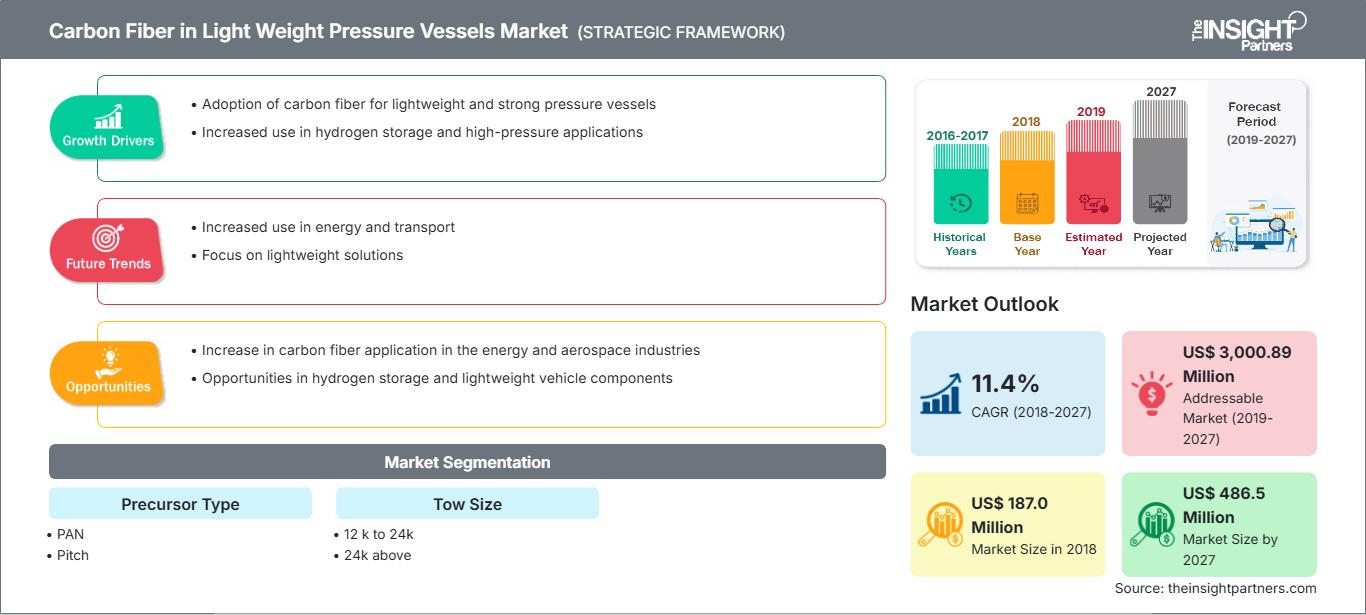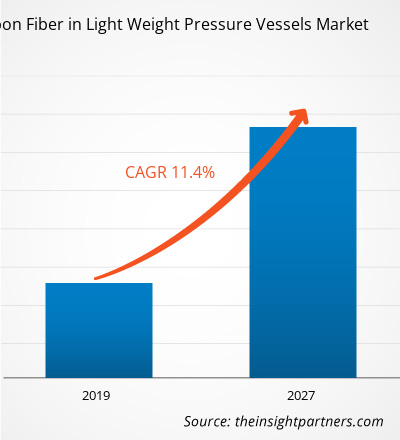경량 압력 용기용 탄소 섬유 글로벌 시장은 2018년에 1억 8,700만 달러 규모였으며, 2019년~2027년 예측 기간 동안 11.4%의 CAGR로 성장하여 2027년에는 4억 8,650만 달러 규모에 이를 것으로 예상됩니다.
아시아 태평양 지역은 인구 증가와 인도, 중국, 일본 등의 국가에서 정부의 환경 문제 심화, 에너지 효율적이고 환경 친화적인 CNG 차량에 대한 관심 증가로 인해 탄소 섬유 기반 압력 용기가 가장 빠르게 성장하는 지역입니다. 또한, 자동차 산업의 수요 증가는 이 지역의 경량 압력 용기용 탄소 섬유 시장 성장을 촉진할 것으로 예상됩니다.
시장 분석: 자동차 및 산업 분야의 수요 증가는 경량 압력 용기용 탄소 섬유 시장 성장에 기회를 제공합니다.
탄소 섬유는 높은 탄성률과 비강도, 높은 피로 강도, 높은 강성, 높은 내압성, 낮은 열팽창 계수, 내식성 등 다양한 장점을 제공하여 자동차 및 기타 산업 분야의 압력 용기에 유용하게 사용됩니다. 또한, 경량 소재에 대한 수요 증가와 유해 가스 배출 감축 및 연비 향상을 위한 정부 정책은 자동차 분야의 경량 압력 용기용 탄소 섬유 시장을 견인할 것으로 예상됩니다.
요구 사항에 맞게 이 보고서를 사용자 정의하십시오.
이 보고서의 일부, 국가 수준 분석, Excel 데이터 팩을 포함하여 모든 보고서에 대한 사용자 정의를 무료로 받을 수 있을 뿐만 아니라 스타트업 및 대학을 위한 훌륭한 제안 및 할인을 이용할 수 있습니다
경량 압력 용기 시장의 탄소 섬유: 전략적 통찰력

- 이 보고서의 주요 주요 시장 동향을 확인하세요.이 무료 샘플에는 시장 동향부터 추정 및 예측에 이르기까지 데이터 분석이 포함됩니다.
연료전지 차량에 탄소 섬유 기반 압력 용기를 적용하는 사례가 증가함에 따라 전 세계 경량 압력 용기용 탄소 섬유 시장의 성장 기회가 창출될 것입니다.
이 보고서의 일부, 국가 수준 분석, Excel 데이터 팩을 포함하여 모든 보고서에 대한 사용자 정의를 무료로 받을 수 있을 뿐만 아니라 스타트업 및 대학을 위한 훌륭한 제안 및 할인을 이용할 수 있습니다
경량 압력 용기 시장의 탄소 섬유: 전략적 통찰력

- 이 보고서의 주요 주요 시장 동향을 확인하세요.이 무료 샘플에는 시장 동향부터 추정 및 예측에 이르기까지 데이터 분석이 포함됩니다.
전 세계 경량 압력 용기용 탄소 섬유 시장은 고압 수소 가스 저장용 밀폐 용기에 사용되는 탄소 섬유에 대한 수요가 증가할 것으로 예상됩니다. 탄소 섬유는 고압 수소를 유지할 수 있는 능력을 갖추고 있어 신뢰성 있고 안전한 압력 용기 생산에 최적의 선택으로 여겨지며, 이로 인해 전 세계 자동차 제조업체들이 연료전지 차량 개발에 적극적으로 참여하고 있으며, 각국 정부 또한 연료전지 차량 생산을 위한 인프라 구축을 지원하고 있습니다.
전구체 분석
전구체를 기준으로 전 세계 경량 압력 용기용 탄소 섬유 시장은 폴리아크릴로니트릴(PAN)과 피치로 구분됩니다. 폴리아크릴로니트릴(PAN) 부문은 전 세계 경량 압력 용기용 탄소 섬유 시장을 주도했습니다. 폴리아크릴로니트릴(PAN)은 약 68%의 탄소를 함유한 탄소 섬유로, 가장 널리 사용되는 탄소 섬유 전구체 중 하나입니다. PAN은 아크릴로니트릴(AN)에 아조 화합물 및 과산화물과 같은 일반적으로 사용되는 억제제를 첨가하여 중합 공정을 통해 중합됩니다. 경량 압력 용기용 탄소 섬유에 대한 수요 증가로 PAN은 가장 널리 사용되는 전구체 중 하나이기 때문에 제조 및 생산이 급증했습니다.
토우 크기 분석
전 세계 경량 압력 용기용 탄소 섬유 시장은 토우 크기별로 12k~24k 및 24k 이상으로 구분됩니다. 12k~24k 세그먼트는 전 세계 경량 압력 용기용 탄소 섬유 시장에서 가장 큰 점유율을 차지했습니다. 12K~24K 토우 사이즈 탄소 섬유는 무겁고 강성이 뛰어나 군사 및 과학 장비 분야에서 유용하며, 이는 전 세계적으로 12K~24K 토우 사이즈 탄소 섬유의 성장과 확장에 기여하는 주요 요인입니다. 12K~24K 탄소 섬유를 생산하는 주요 기업으로는 Toray Composite Materials America, Inc., Teijin Limited, SGL 그룹 등이 있습니다.
경량 압력 용기 시장 지역별 탄소 섬유 통찰력
The Insight Partners의 분석가들은 예측 기간 동안 경량 압력 용기용 탄소 섬유 시장에 영향을 미치는 지역별 동향과 요인을 면밀히 분석했습니다. 이 섹션에서는 북미, 유럽, 아시아 태평양, 중동 및 아프리카, 중남미 지역의 경량 압력 용기용 탄소 섬유 시장 부문 및 지역별 현황도 다룹니다.
경량 압력 용기 시장 보고서 범위에 대한 탄소 섬유
| 보고서 속성 | 세부 |
|---|---|
| 시장 규모 2018 | US$ 187.0 Million |
| 시장규모별 2027 | US$ 486.5 Million |
| 글로벌 CAGR (2018 - 2027) | 11.4% |
| 이전 데이터 | 2016-2017 |
| 예측 기간 | 2019-2027 |
| 다루는 세그먼트 |
By 전구체 유형
|
| 포함된 지역 및 국가 | 북미
|
| 시장 선도 기업 및 주요 회사 프로필 |
|
경량 압력 용기 시장 참여자 밀도의 탄소 섬유: 비즈니스 역학에 미치는 영향 이해
경량 압력 용기용 탄소 섬유 시장은 소비자 선호도 변화, 기술 발전, 그리고 제품의 이점에 대한 인식 제고 등의 요인으로 인한 최종 사용자 수요 증가에 힘입어 빠르게 성장하고 있습니다. 수요 증가에 따라 기업들은 제품 라인업을 확장하고, 소비자 니즈를 충족하기 위한 혁신을 추진하며, 새로운 트렌드를 적극 활용하고 있으며, 이는 시장 성장을 더욱 가속화하고 있습니다.

- 을 얻으세요 경량 압력 용기 시장의 탄소 섬유 주요 주요 플레이어 개요
합병 및 인수, 투자 시나리오, 신제품 개발 등이 글로벌 경량 압력 용기용 탄소 섬유 시장에서 가장 많이 채택된 전략으로 나타났습니다. 다음은 최근 경량 압력 용기용 탄소 섬유 글로벌 개발 사례입니다.
- 2019년: Teijin Limited는 Renegade Materials Corporation(Renegade)을 인수하기로 합의했습니다. Teijin은 이를 통해 탄소 섬유 및 중간재 사업을 강화하여 항공우주 응용 분야 솔루션의 선도적 공급업체로서의 입지를 유지하고자 합니다.
- 2018년: Toray Industries Inc.는 Koninklijke Ten Cate BV와 자회사 TenCate Advanced Composites Holding BV의 모든 주식을 매수하기로 계약을 체결했습니다. 이 인수는 후자의 제품 라인업과 탄소 섬유 및 폴리머 기술을 결합하여 상당한 시너지 효과를 낼 것으로 예상됩니다.
- 2017년: Hexcel은 탄소 섬유 직물 연구 개발에 740만 파운드를 지원받은 새로운 정부 산하 기업인 MAXIM을 출시하고 레스터에 있는 제조 시설을 확장했습니다.
경량 압력 용기용 탄소 섬유 글로벌 시장 세분화
선구자별
- 폴리아크릴로니트릴(PAN)
- 피치
견인 크기별
- 12k ~ 24k
- 위 24k
지역별
북쪽 미국
- 미국
- 캐나다
- 멕시코
유럽
- 독일
- 프랑스
- 이탈리아
- 영국
- 러시아
- 나머지 국가 유럽
아시아 태평양
- 호주
- 중국
- 인도
- 일본
- 한국
- 아시아 태평양 지역
전 세계 지역
- 브라질
- 아르헨티나
- 남미 지역(SAM)
회사 프로필
- 효성(주)
- 솔베이
- 포모사 플라스틱(주)
- 도레이(주)
- 테이진(주)
- SGL 카본
- 미쓰비시 케미컬(주)
- 구레하(주)
- 헥셀(주)
- 도왁사(주)
- 과거 분석(2년), 기준 연도, CAGR을 포함한 예측(7년)
- PEST 및 SWOT 분석
- 시장 규모 가치/거래량 - 글로벌, 지역, 국가
- 산업 및 경쟁 환경
- Excel 데이터세트
최근 보고서
관련 보고서
사용 후기
구매 이유
- 정보에 기반한 의사 결정
- 시장 역학 이해
- 경쟁 분석
- 고객 인사이트
- 시장 예측
- 위험 완화
- 전략 기획
- 투자 타당성 분석
- 신흥 시장 파악
- 마케팅 전략 강화
- 운영 효율성 향상
- 규제 동향에 발맞춰 대응




















 무료 샘플 받기 - 경량 압력 용기 시장의 탄소 섬유
무료 샘플 받기 - 경량 압력 용기 시장의 탄소 섬유